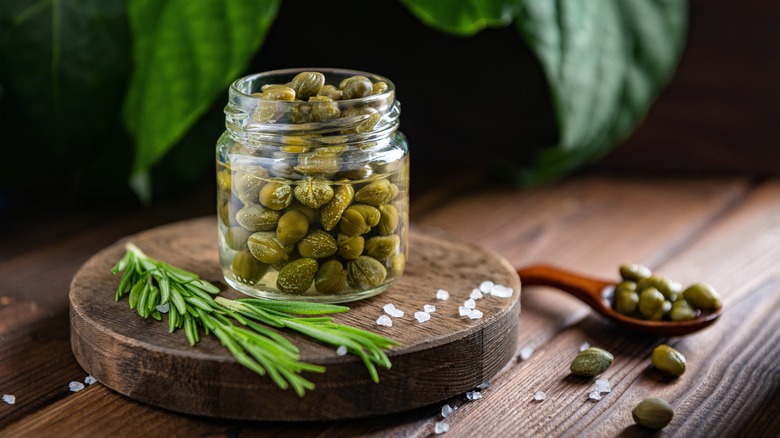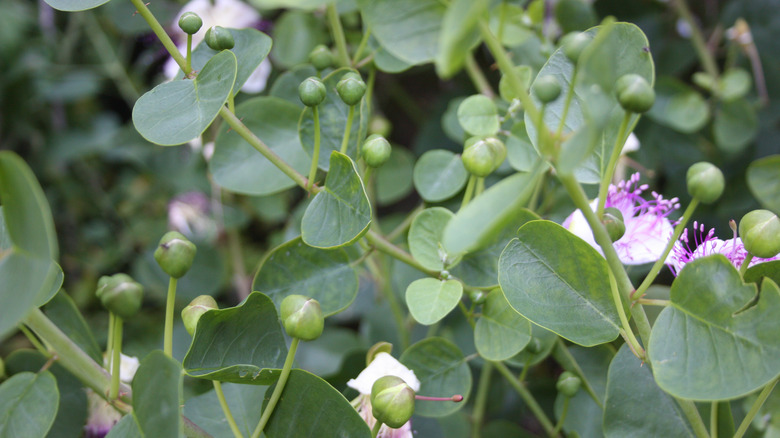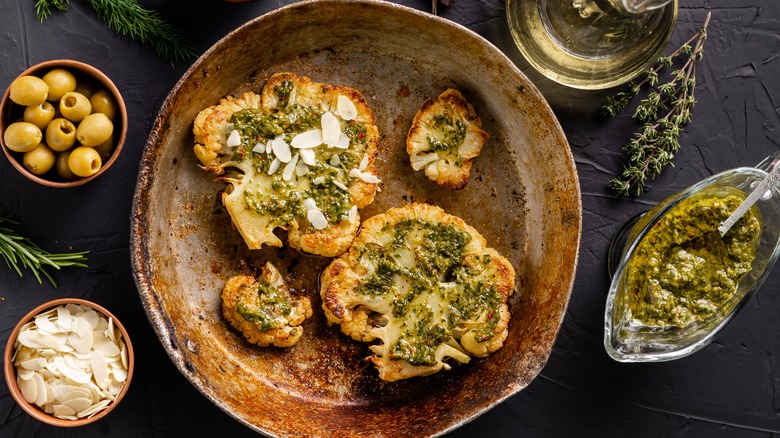What Are Capers And How Can You Use Them?
Capers pack a powerful flavor punch, despite their small size. These tiny buds will kick your pesto up a notch, but you can also use them in omelets, frittatas, sandwiches, and other everyday meals. Their tangy taste makes them ideal for salads, antipasto platters, chicken or fish dishes, sauces, and everything in between. But have you ever wondered where capers come from? Are they fruits or vegetables?
As it turns out, these little green things are the immature flower buds of a Mediterranean shrub called Capparis spinosa. They're widely found in Spain, Italy, Portugal, and other Mediterranean countries, as well as in northern Africa and some regions of Asia. The ones available in stores are pickled or salted, which allows manufacturers to preserve their flavor. From a nutritional standpoint, capers contain more quercetin than any other food and, therefore, support brain and heart health. Their anti-cancer and anti-inflammatory properties shouldn't be overlooked, either.
Note that capers are different from caperberries. While both come from the same plant, the latter is the ripe fruit of Capparis spinosa. Conversely, capers are picked before they bloom, then dried and pickled in vinegar or brine. Their flavor is sharper and tangier than that of caperberries, making them suitable for savory dishes. Caperberries are typically used in cocktails, but you may serve them with pizza, grilled meats, or roasted veggies, too.
Capers are actually fruits, not vegetables or seeds
The caper plant has been used as medicine for thousands of years. Its root, bark, and fruits are believed to treat gout, malaria, kidney disease, and other ailments, notes a 2022 review published in "Frontiers in Pharmacology." For example, in Morocco people use many parts of the caper bush, including the unopened buds, dried fruits, and the leaves, to treat ailments like high blood pressure, diabetes, and eye infections.
These unripe fruits are hand-picked just before blooming. At this point, they're unfit for consumption because of their bitterness. Once harvested, the buds are soaked in water to dilute their bitter intensity. Later, they are left to dry in the sun and then stored in brine for a week or longer. Some producers will use vinegar and wine or salt water for pickling and may add spices or herbs to the mix. They're also sold marinated in olive oil.
Capers come in several varieties, including a gourmet version measuring under 7 millimeters in diameter. This food product is usually labeled "non-pareil," featuring a distinct flavor and super-fine texture. By comparison, surfines are 7 to 8 millimeters in diameter, whereas grusas can exceed 14 millimeters. Larger varieties are cheaper and have a stronger, more pungent flavor than non-pareilles and surfines. Additionally, salt-packed capers have a different aroma than those brined in vinegar or wine.
How to use capers in your recipes
These tiny flavor bombs are very salty and should be used sparingly. A tablespoon of capers should suffice for most recipes, whether we're talking about sauces, fish stews, or salads. For example, you'll only need 2 teaspoons of these green buds to make 12 servings of remoulade sauce. First, rinse the capers with water or milk to bring down the saltiness. Pat them dry with kitchen paper, and then decide how you'll use them.
Some recipes suggest frying the capers before adding them to cooked meals, but that's not the best idea. These little buds can pop in the pan and splash the oil all over the place. Ideally, use them raw or add them toward the end of the cooking process. Sprinkle them on cooked meats or fish, scrambled eggs, pasta dishes, or seafood salads, or crush them and mix them into sauces. For instance, caper-raisin relish requires mixing capers, red pepper flakes, dark raisins, anchovy fillets, and other ingredients in a bowl. After that, you'll add the sauce to fish dishes, grilled chicken, pasta, and other cooked meals.
Capers also go well with cheese, tomatoes, butter, potatoes, and leafy greens. Plus, they can replace olives, relish, or dill pickles in most recipes. Just beware of their sodium content, especially if you have high blood pressure. A single tablespoon of capers boasts over 200 milligrams of sodium, which is around 9% of the maximum recommended daily intake.


